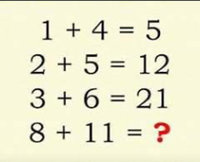Didn't we have another question recently that asked about the function, f(x,y) such that f(1, 4)= 6, f(2, 5)= 12, and f(3, 6)= 21?
To that post (perhaps it was on a different board) I answered that, since we have 3 equations, we have 3 pieces of information so can solve for three numbers. The simples thing to do is write f(x, y)= Ax+ By+ C for some constants, A, B, and C. Then f(1, 4)= A+ 4B+ C= 6, f(2, 5)= 2A+ 5B+ C= 12. and f(3, 6)= 3A+ 6B+ C= 21.
If we subtract the first equation from the second C cancels and we get A+ B= 6. If we subtract the first equation from the third C cancels again and we get 2A+ 2B= 15. If A+ B= 6 then 2A+ 2B= 12, not 15 so that is impossible.
Instead try f(x,y)= Ax^2+ By+ C. Then f(1, 4)= A+ 4B+ C= 6, f(2, 5)= 4A+ 5B+ C= 12, and f(3, 6)= 9A+ 6B+ C= 21. Subtract the first equation from the second again, this time getting 3A+ B= 6. Subtract the first equation from the third again getting 8A+ 2B= 15. Multiply 3A+ B= 6 by 2 to get 6A+ 2B= 12 and subtract that from 8A+ 2B= 15 to get 2A= 3 so A= 3/2. Then 3A+ B= 9/2+ B= 6 so B= 6- 9/2= 3/2 also. And A+ 4B+ C= 3/2+ 12/2+ C= 15/2+ C= 6 so C= 12/2- 15/2= -3/2.
One possible function is f(x, y)= (3/2)x^2+ (3/2)y- 3/2= (3/2)(x^2+ y- 1).
Check:
f(1, 4)= (3/2)(1+4- 1)= (3/2)(4)= 6.
f(2, 5)= (3/2)(4+ 5- 1)= (3/2)(8)= 12
f(3, 6)= (3/2)(9+ 6- 1)= (3/2)(14)= 21
So one possible function (out of many) satisfying f(1, 4)= 6, f(2, 5)= 12, and f(3, 6)= 21 is f(x, y)= (3/2)(x^2+ y- 1)


